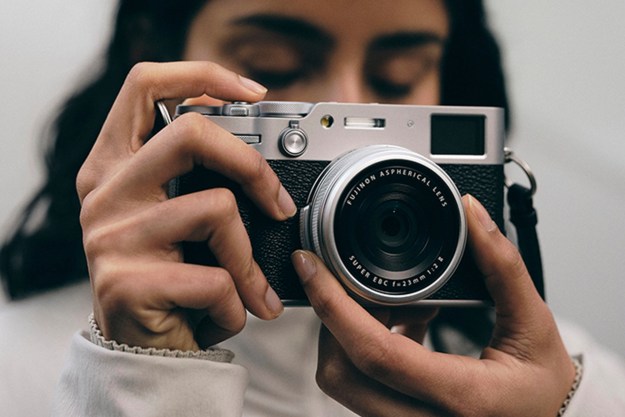
It’s not every day you get the chance to shoot four new cameras at a series of locations that pack more challenges than an extreme wilderness trek. Yet that’s exactly what occurred over the course of three days last week. Sony brought a group of reviewers to Southern California to test the SLT-A77, SLT-A65 — a pair of 24-megapixel DSLRs — and the NEX-5N and NEX-7, two compact mirrorless cameras. The NEX-5N has a 16.2-megapixel sensor while the NEX-7 packs 24, the same as the DSLRs. To put the cameras through their paces, we shot hot-dogging motocross riders, hang gliders soaring off cliffs, surfing dogs, aerial shots from hot air balloons, tried to capture a speeding cheetah — photographically, of course — and even a revival meeting. Thankfully, we had 32GB cards to switch from camera to camera. Over the test period we took over 1,200 stills and dozens of short videos. The details follow but the quick takeaway is this — if you’re seriously looking for new cameras, give all of them a very close look.
Check out our full reviews of the Sony NEX-5, Sony NEX-7 and the Sony Alpha SLT-A77.
Features and design
The SLT-A77 and –A65 are Sony’s newest DSLRs and will be available shortly (October). Both have 24.3-megapixel APS-C sensors and feature the company’s Translucent Mirror Technology, also found in the SLT-A55, a camera we liked so much we gave it an Editor’s Choice designation. TMT allows for faster, more accurate focusing and uses phase detection so your videos are much more fluid than camera with contrast detection, the system used by all other video-shooting DSLRs. This is all well and good, but Sony really leaped ahead with this new pair by upping still resolution, the frame rate, video quality and incorporating a high-quality OLED viewfinder. Resolution is now 24.3 megapixels, the most of any consumer camera (although Samsung is relatively close at 20.3MP with the new NX200). Even with all the pixels, the A77 cranks off 12 frames per second at full resolution; the less expensive A65 does 10. Both also capture AVCHD Progressive movies, which are a beautiful 1080p resolution at 60 frames per second, rather than 1080i. The OLED EVF is rated 2.3-million pixels and lets you preview your adjustments in the viewfinder. All of this is pretty amazing stuff. The A77 costs $1,399 for the body only and is sold with an extremely sharp constant-aperture f/2.8 16-50mm lens for around $2,000. The A65 costs $999 with a more traditional 18-55mm lens. As a comparison, the 3.7 fps 18-megapixel Canon EOS Rebel T3i is $899 with an 18-55mm lens.

The A65 has the main features of the A77, but is not nearly as tank-like. You get 24-megapixel stills, AVCHD Progressive movies and the OLED EVF, but the burst rate drops slightly, the 15-point focusing system has only three cross sensors, shutter speed tops out at 1/4000 and there’s no top-deck LCD status display. These are the typical differences between sub-$1,000 DSLRs and their more expensive brethren.

Mirrorless cameras like the NEX series, — Olympus PENs, Panasonic Lumix G Series and Samsung NX models — have larger sensors than point-and-shoots, interchangeable lens capability, and take HD video in much smaller bodies than the typical DSLR. Sony’s first were the NEX-3 and NEX-5, which gave way to the C3 and 5N. The C3 has been out for a few months, but the 5N is brand new, and the NEX-7 is due in November. The NEX-5N has a 16-megapixel APS-C sensor (up from 14) and costs $699 with an 18-55mm kit lens. The NEX-7 has the same sensor as the A77 and A65, and an OLED viewfinder, the first for any mirrorless camera. This is a critical feature for this new model. One of the drawbacks of most compact interchangeable lens cameras is the fact you only have an LCD screen to frame your shots. Sure, you can add an accessory viewfinder for another $200 or more, but it’s definitely a limitation. The NEX-7 has the high-quality finder built-in on the rear top left; the view is very good. We used the camera with an f/2.0 24mm prime lens, which added a cool $1,200 to the basic $1,149 price for the body. The NEX-7 will be sold with a cosmetically-matching black 18-55mm lens for $1,349. This outfit has a very Leica-like vibe and takes some pretty spectacular images.
Performance and use
We won’t bore you with a shot-by-shot recap. Just reviewing our images and videos took several hours. We’ll state Sony’s new DSLRs will really give Canon and Nikon serious competition. We know it’ll be hard for anyone with a collection of lenses to switch platforms, but those without a major investment or are moving up from a point-and-shoot should seriously consider the A77 or A65, depending on their budget. Yes, we know some will say 24.3-megapixels is overkill, but once you examine the images closely on your monitor or see them on a 50-inch HDTV, you’ll be amazed. With the right light, you can easily do 200-percent blowups. This means you can crop your shots and still make large prints. We were very impressed by the quality, accuracy and richness of the colors we captured.
Hot air balloons are great subjects—especially on sunny days. We got some great photos of them being filled, launched and while in the air. That’s not a really big deal, but we shot a worker’s arms as he tied ropes while still Earthbound and the picture was magnificent—if we say so ourselves. It was taken with a $2,000 rig (A77 and the 16-50mm lens) but we hadn’t seen files like this since we tested the Canon EOS 5D Mark II — which costs $2,499 for the body alone. And that older camera certainly doesn’t take 12 fps bursts or 1080/60p videos.

During the course of our adventures, we had the chance to shoot hang gliders, motocross riders and surfers. We’ll admit to our shortcomings as sports photographers; we hold them in high esteem—years of practice and thousands of dollars of gear will do that. Yet the cameras tested certainly gave us far more sharply-focused action shots than usual. As mentioned earlier, the two DSLRs have 12 and 10 fps burst rates respectively, but we had better results using the fastest setting in shutter-priority mode. Some of the motocross images were spot on. For the cheetah run at the San Diego Zoo’s Safari Park, we tried 12 fps and couldn’t get a sharp image. Live and learn.
New this year for Sony DSLRs is an extensive list of filters such as posterization, high-contrast B&W, toy camera, and so on. The cool thing is, you can check them out in the OLED viewfinder before you snap the shutter. We used these options judiciously and found them quite enjoyable. The OLED finder is also a pleasure to use.

Videos shot with the DSLRs were very good, the best we’ve seen from this type of camera. We said the same thing about the A55 last year, and Sony remains at the head of the pack when it comes to SLR movies. You simply can’t beat phase-detection AF for lifelike motion, and only the Sonys have it.

And now for the sleeper of the bunch—the NEX-7. Unlike the three other cameras, the NEX-7 wasn’t quite ready for prime time. There were just a few working samples and all the technical adjustments had not been finalized; the others were as close to “real” as can be other than being packed in a shrink-wrapped carton. The NEX-7 has a 24.3-megapixel sensor and takes AVCHD Progressive videos, the highest specs of any mirrorless camera. What’s really nice about this one is the built-in OLED viewfinder, so you never have to worry about the screen wiping out in bright sunshine. That was working fine, and it was a pleasure taking close-ups of plants at the botanic gardens at Balboa Park in San Diego. The vast majority of mirrorless cameras require an optional finder if you want to go this route, rather than being at the mercy of the LCD. We loved walking around shooting with the f/1.8 Sonnar T 24mm lens in the bright California sunshine. Images of Spanish architecture and statuary in the park looked fantastic — and this was with a camera that wasn’t nearly finalized. Also of note is the TriNavi operation. Unlike Sony’s other mirrorless cameras, which operate primarily via touchscreen, the NEX-7 has customizable dials that have a bit of an analog throwback feel. Don’t fret, they’re as digital as can be, including an extremely sophisticated histogram. We can’t wait for the finished version so we can give it a proper test.
Conclusions
Sony has taken a huge leap forward with the introduction of these cameras. Although the NEX-7 still requires a final production sample test, the early taste was quite fine. This could easily be the camera of the year given our hands-on experience. The buzz among the reviewers was pretty intense. There’s no need to belabor the DSLRs—just buy one in your price range if you’re in the market. As for the NEX-5N, although it’s a nice camera, it really paled in comparison to its big brothers and sisters. Too bad but that’s life in sunny California.
Editors' Recommendations
- Sony A7S III hands-on: Confessions of a devout Panasonic user
- After years of waiting, Sony A7S III may arrive this summer


